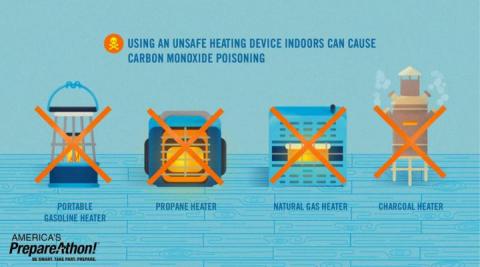 Safe home heating tips
Safe home heating tips

Improper use of portable heating equipment can lead to fire or dangerous levels of carbon monoxide. Take precautions to ensure you are heating your home safely.
Carbon monoxide safety tips
Install a carbon monoxide detector in your home and check it regularly to make sure the battery is working. Make sure your heating system is kept clean and properly vented; have worn or defective parts replaced. Have your fireplace, chimney, and flue cleaned every year to remove soot deposits, leaves, etc.
Kerosene heaters are dangerous and illegal in the City of Colorado Springs. Don't heat your home with a gas stove or oven. Do not use any gas-powered appliance, such as a generator, indoors. Never use a charcoal grill or a hibachi indoors.
Automobile exhaust contains carbon monoxide. Open your garage door before starting your car and do not leave the motor running in an enclosed area. Clear exhaust pipes before starting a car or truck after it snows.
The most common symptom of carbon monoxide poisoning is headache. However, symptoms may also include dizziness, chest pain, nausea, and vomiting. In severe cases, people can become increasingly irritable, agitated and confused, eventually becoming lethargic and lapsing into unconsciousness.
If you suspect carbon monoxide poisoning, call 911, and get the victim to fresh air immediately, and open windows.
For more information on safe home heating, watch our CityTalk segment about it here.
Fire safety tips
Use only portable heating equipment that is approved for indoor use. Keep combustible materials, including furniture, drapes, and carpeting at least three feet away from the heat source. NEVER drape clothes over a space heater to dry.
Always keep an eye on heating equipment. Never leave children alone in the room where a space heater is running. Turn it off when you are unable to closely monitor it. Be careful not to overload electrical circuits. Keep anything that can burn at least three feet away. Never store or use flammable or combustible liquids near or in rooms with heaters. Make sure you have a working smoke detector in every room. Check and change batteries often.
What to do if you lose heat
If you lose heat, take measures to trap existing warm air, and safely stay warm until heat returns:
- Insulate your home as much as possible. Hang blankets over windows and doorways and stay in a well-insulated room while power is out.
- Dress warmly. Wear hats, scarves, gloves, and layered clothing.
- If you have a working fireplace, use it for heat and light, but be sure to keep the damper open for ventilation.
- Open your faucets to a steady drip so pipes do not freeze.
- Eat. Food provides your body with needed energy to produce its own heat and drinking helps your body avoid dehydration.
- If the cold persists and your heat is not restored, call family, neighbors, or friends to see if you can stay with them.
Stay warm outdoors
Watch for signs of frostbite such as loss of feeling and white or pale appearance in fingers, toes, ear lobes, and the tip of the nose. Watch for signs of hypothermia including uncontrollable shivering, memory loss, disorientation, incoherence, slurred speech, drowsiness, and apparent exhaustion.
To assist a hypothermia victim:
- Move the victim to a warm location.
- Remove wet clothing.
- Put the person in dry clothing and wrap his/her entire body in a blanket.
- Warm the center of the body first.
- Give warm, non-alcoholic or non-caffeinated beverages if the victim is conscious.
- Get medical help as soon as possible.
